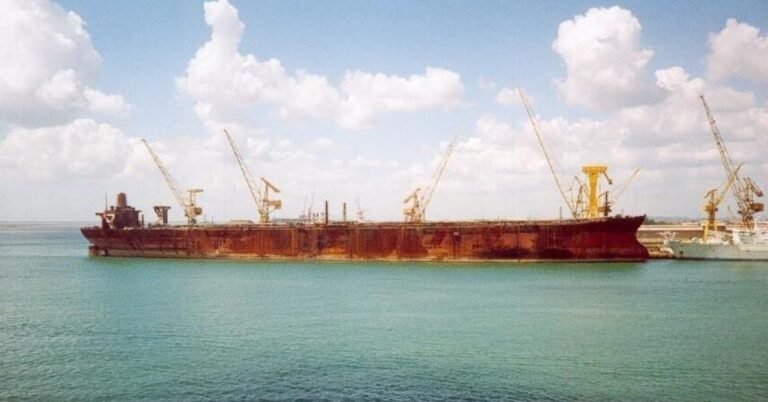The biggest oil tanker ever constructed is none other than the Seawise Giant, known by many names throughout its long and difficult life span. It was also known as Happy Giant, Jahre Viking, Knock Nevis, and lastly Mont.
The ULCC supertanker was the longest and heaviest self-propelled ship in maritime history, constructed by Sumitomo Heavy Industries in Yokosuka, Kanagawa, Japan.
It had the greatest deadweight tonnage ever recorded. While fully laden, its displacement was 657,019 tonnes. Seawise Giant had a Gross Tonnage of 260,941 tonnes and a deck space of 31,541 sq m.
The journey of the biggest oil tanker began in 1974 when a Greek businessman placed an order for it; however, he backed out due to financial difficulties.
The shipyard had a half-built ship, and in 1981, Hong Kong Shipping Magnate Tung Chao-Yung, founder of Orient Overseas Container Line or OOCL, acquired the unfinished hull.
Tung ordered the vessel to be increased in size, so an additional section was inserted into its hull to increase its length and cargo capacity.
When completed and relaunched in 1981, it was named the Seawise Giant. Its massive dimensions made it a centre of attention in the maritime industry, and everyone who saw it for the first time was left in awe of its size.
It boasted an LOA of 458.45 m or 1504.1 feet, longer than the Empire State Building and equal to four and a half football fields laid end to end.
The biggest oil tanker was 68.8 m wide, around the width of a typical American football field. Its draft, when fully loaded, was 24.6 m, which made it incapable of navigating the English Channel, the Suez Canal or the Panama Canal.
Its cargo capacity was around 4.1 million barrels of crude oil, enough to fill about 1500 Olympic-sized swimming pools.
It was powered by a single steam turbine with a maximum power output of 50,000 horsepower.
The supertanker could attain a speed of 16.5 knots or 30.6 km/h and needed atleast 5.5 miles to halt from full speed and a turning circle of 2 miles.
In its early years, it shipped crude oil between the Middle East and the U.S, although its gigantic size brought difficulties as it could not enter most ports and required specialised manoeuvring.
The supertanker was damaged during the Iran-Iraq War in the 1980s. In May 1988, it was anchored off Iran’s Larak Island, loaded with Iranian Crude Oil, when it became the target as Iraqi fighter jets launched Exocet missiles at the tanker, which led to massive fire and explosions. Though the crew escaped, the tanker sank in shallow waters and was declared a total loss by its insurers.
After the conflict ended, the Norwegian Company, Norman International, bought the shipwreck and undertook it upon itself to salvage and repair the ship, recognising its massive potential.
After being towed to the Keppel Shipyard in Singapore, extensive work was carried out, and in October 1991, it was renamed Happy Giant.
However, the same year, the Norwegian Shipping Magnate Jorgen Jahre acquired the biggest oil tanker and renamed it the Jahre Viking.
In 2004, it was again sold to Singapore-based First Olsen Tankers, who renamed it Knock Nevis and converted it into a Floating Storage and Offloading (FSO) unit.
It was permanently moored in Qatar’s Al Shaheen Oil Field in the Persian Gulf, serving as a massive storage facility for crude oil, functioning as a vital part of the offshore oil sector.
By 2009, it had become old and neared its end, after over 30 years of service. It was sold for scrap to the Amber Development Corporation and embarked on its final voyage under its last name, Mont.
It sailed to Alang in the Indian State of Gujarat, one of the largest ship-breaking yards in the world. On December 22, 2009, it was beached and the process of dismantling started.
The scrapping was done by 2010, and the biggest oil tanker was gone.
Conclusion
Though the Seawise Giant no longer exists, its legacy remains etched in the annals of maritime history as one of the mightiest tankers of its time. The supertanker’s unparalleled dimensions and capacity pushed the boundaries of what was thought possible for shipbuilding. The challenges it faced, from its birth to the damages it suffered during the war, highlight the dynamic nature of the shipping industry and the evolving technological landscape, which made its repairs possible.
Seawise Giant was featured on the BBC series Jeremy Clarkson’s Extreme Machines while it sailed as Jahre Viking. Captain S. K. Mohan said it could reach up to 16.5 knots in good weather.
Today, its memory lives in documentaries and museums and is remembered as a Behemoth that dwarfed all other ships.
You might also like to read-
different words.

